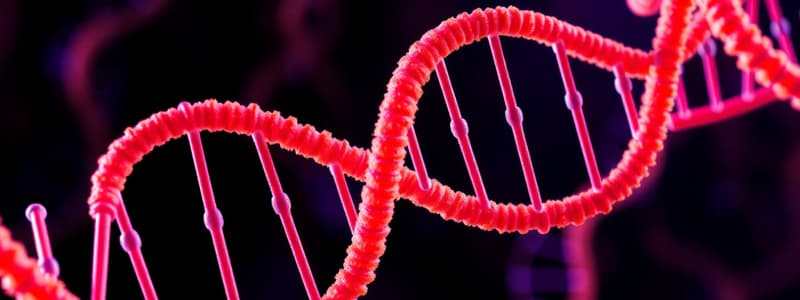Podcast
Questions and Answers
What process involves the assembly of nucleotides by RNA polymerase?
What process involves the assembly of nucleotides by RNA polymerase?
- Replication
- Transcription (correct)
- Translation
- Splicing
Which codon serves as the start signal for protein synthesis?
Which codon serves as the start signal for protein synthesis?
- UAG
- AUG (correct)
- UAA
- UGA
What is removed during the splicing process of mRNA?
What is removed during the splicing process of mRNA?
- Promoters
- Codons
- Introns (correct)
- Exons
During which stage is mRNA exported to the cytoplasm?
During which stage is mRNA exported to the cytoplasm?
What are the intermediary molecules that match amino acids to codons in mRNA?
What are the intermediary molecules that match amino acids to codons in mRNA?
What is the primary function of the process of translation?
What is the primary function of the process of translation?
How many bases are in a triplet codon?
How many bases are in a triplet codon?
What do stop codons signal during the translation process?
What do stop codons signal during the translation process?
Which part of the tRNA is responsible for base-pairing with the mRNA codon?
Which part of the tRNA is responsible for base-pairing with the mRNA codon?
What is the function of RNA polymerase in the transcription process?
What is the function of RNA polymerase in the transcription process?
Flashcards
Transcription process
Transcription process
Assembly of nucleotides by RNA polymerase to create an RNA copy of DNA
Start codon
Start codon
AUG, signals the start of protein synthesis.
Introns
Introns
Non-coding segments removed during mRNA processing.
Splicing
Splicing
Signup and view all the flashcards
tRNA
tRNA
Signup and view all the flashcards
Translation
Translation
Signup and view all the flashcards
Codon length
Codon length
Signup and view all the flashcards
Stop codons
Stop codons
Signup and view all the flashcards
Anticodon
Anticodon
Signup and view all the flashcards
RNA polymerase function
RNA polymerase function
Signup and view all the flashcards
Study Notes
Transcription Process
- Transcription is the process where DNA is converted into RNA.
- The DNA code is transcribed into a sequence of codons in messenger RNA (mRNA) within the cytoplasm.
- RNA polymerase is the enzyme that binds to the promoter region to initiate transcription and assembles nucleotides.
Codons and Amino Acids
- Each triplet of mRNA nucleotides (codon) corresponds to a specific amino acid.
- The start codon is AUG, which codes for methionine, marking the beginning of protein synthesis.
- Stop codons UAA, UAG, and UGA signal the end of translation.
Splicing
- Splicing is the process that removes non-coding regions (introns) from the pre-mRNA, leaving only the coding segments (exons).
- The mature mRNA, now consisting only of exons, can be translated into a protein.
Stages of Gene Expression
- Transcription (1): Information from DNA is read to produce mRNA.
- Splicing (2): The mRNA is processed to remove introns, producing a shorter, functional strand.
- Translation (3): The mRNA is used as a template to assemble amino acids into a protein.
Translation Process
- Translation occurs in the cytoplasm after mRNA is spliced and exported from the nucleus through nuclear pores.
- Ribosomes bind to the mRNA at the start codon AUG to initiate protein synthesis.
- Transfer RNA (tRNA) serves as an intermediary, matching specific amino acids to their corresponding codons in mRNA.
- Each tRNA carries a specific amino acid on one end and has an anticodon on the other end that pairs with the mRNA codon during translation.
Studying That Suits You
Use AI to generate personalized quizzes and flashcards to suit your learning preferences.



